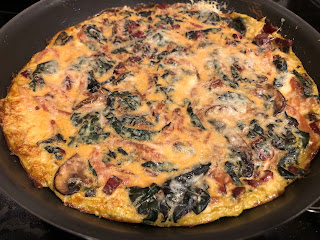
Recipe: Classic brunch dish uses this easy plant to grow and to cook

(Photos: Kathy Morrison) |

Add cheese or other veggies if you like. |
Chard and onion frittata
Serve 4-6
Ingredients :
8 stalks chard, washed thoroughly
Extra virgin olive oil
1 onion, thinly sliced
4 cloves garlic, minced
5-6 mushrooms, stemmed and sliced (optional)
Sea salt
6 eggs
Freshly ground black pepper
1/2 teaspoon dried basil, thyme or herb of your choice
Cayenne pepper (optional)
3 tablespoons grated Parmesan or other cheese
Instructions :
Remove the thick part of the stalks from the chard. Slice the leaves and tender part of the stalk no wider than about 1 inch. Chop up about half of the thicker stalk pieces, save the remainder for another project, if desired. (Pickle them, perhaps?) You should have about 6 cups of leaves and small stalk pieces.
Heat 1 tablespoon of the olive oil in a 10-inch nonstick skillet. Add the onion and saute a few minutes, until the slices begin to soften. Stir in the stalks; the onion will pick up some of the color, but that’s OK.
Once the stalks start to cook, add the mushroom slices, if using, Then add the garlic and cook another few minutes. Finally, add the chard and a pinch of salt. It will look like a lot of leaves, but don’t worry, they will shrink down plenty after a few minutes. Continue cooking until all the leaves are wilted. Remove from heat and let cool while you prepare the eggs.

Crack all the eggs into a large bowl, then add 1/8 teaspoon salt, 2 teaspoons of olive oil, some grinds of black pepper, the 1/2 teaspoon (or more) of herbs, and, if desired, a pinch of cayenne. Beat lightly with a fork or whisk. Then stir the chard mixture into the eggs.
Preheat the broiler on the oven. Wipe out the skillet, and put it back over medium-high heat. Add 2 tablespoons olive oil and swirl it around in the pan. Once the oil starts to heat up, pour in the egg mixture. As the eggs set on the bottom, tip the pan to allow the uncooked egg to slip underneath. Continue cooking until the frittata is set but still slightly jiggly on top. Remove from heat and sprinkle the cheese over the top. Slide the pan under the broiler, watching it carefully, and remove once the cheese is melted and golden.
Slide the frittata out of the pan onto a large plate, and cut into wedges to serve. This is a great brunch dish, but can be a fine dinner with the addition of a salad and fresh bread.
Comments
0 comments have been posted.Sacramento Digs Gardening to your inbox.
Sites We Like
Garden Checklist for week of April 21
This week there’s plenty to keep gardeners busy. With no rain in the immediate forecast, remember to irrigate any new transplants.
* Weed, weed, weed! Get them before they flower and go to seed.
* April is the last chance to plant citrus trees such as dwarf orange, lemon and kumquat. These trees also look good in landscaping and provide fresh fruit in winter.
* Smell orange blossoms? Feed citrus trees with a low dose of balanced fertilizer (such as 10-10-10) during bloom to help set fruit. Keep an eye out for ants.
* Apply slow-release fertilizer to the lawn.
* Thoroughly clean debris from the bottom of outdoor ponds or fountains.
* Spring brings a flush of rapid growth, and that means your garden is really hungry. Feed shrubs and trees with a slow-release fertilizer. Or mulch with a 1-inch layer of compost.
* Azaleas and camellias looking a little yellow? If leaves are turning yellow between the veins, give them a boost with chelated iron.
* Trim dead flowers but not leaves from spring-flowering bulbs such as daffodils and tulips. Those leaves gather energy to create next year's flowers. Also, give the bulbs a fertilizer boost after bloom.
* Pinch chrysanthemums back to 12 inches for fall flowers. Cut old stems to the ground.
* Mulch around plants to conserve moisture and control weeds.
* From seed, plant beans, beets, cantaloupes, carrots, corn, cucumbers, melons, radishes and squash.
* Plant onion sets.
* In the flower garden, plant seeds for asters, cosmos, celosia, marigolds, salvia, sunflowers and zinnias.
* Transplant petunias, zinnias, geraniums and other summer bloomers.
* Plant perennials and dahlia tubers for summer bloom.
* Mid to late April is about the last chance to plant summer bulbs, such as gladiolus and tuberous begonias.
* Transplant lettuce seedlings. Choose varieties that mature quickly such as loose leaf.